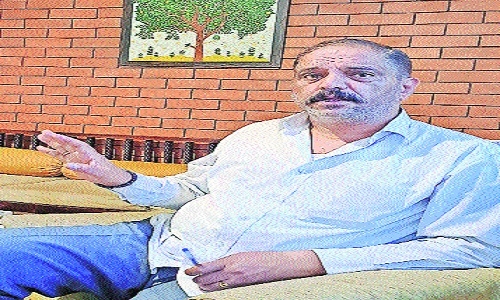‘It’s time for Vidarbha cotton to take Japanese train to world market’
| Date :08-Apr-2023 |

By Kartik Lokhande :
Sudhir Kedar is a man who has seen it all. He is an agriculturist, engineer, banker, and above all an ardent supporter of harnessing Vidarbha’s potential with special emphasis on establishing cotton-garment chain. Having been exposed to local as well as International scenario relating to cotton, Kedar feels that the situation is ripe to invite Japanese textile companies to Vidarbha.
In an interview with ‘The Hitavada’, Kedar shared the ideas from socio-economic as well as purely agricultural perpectives. According to him, Maharashtra has as much as 40-45 lakh hectares of area under cotton cultivation.
This much area is spread across 115 tehsils. Interestingly, eight of 11 districts of Vidarbha region have cotton as a major crop. As far as Nagpur district is concerned, Kedar informed, there were four co-operative spinning mills at Hingna, Patansaongi, Butibori, and Kondhali, one Government-run spinning mill at Kalmeshwar, and several private ones. However, there was only one weaving industry at Butibori. Connecting the dots, Kedar explained the chain starting cotton. Once the cotton is harvested, it goes to ginning mill, and then is pressed into bales,which then go to spinning mills. The yarn made at spinning mills goes to weaving and dyeing units, which fed the garment units. “Unfortunately, in case of cotton, raw material is at one place and finished good is made at another place,” lamented Kedar. There is a reason also for his lament. Having been in agriculture and banking for years together, Kedar is in a position to compare how the economy of sugarcane and cotton crops work. According to him, for 25,000 acres of sugarcane cultivation, a sugar mill of 2,500 tonnes per day (TPD) is there. Late Balasaheb Vikhe Patil brought sugarcane crop in mainstream and established connection between the sugarcane-growers with industries. The sugar mills have Agriculture Department of own to guide farmers.
However, in contrast, though cotton was cultivated in Vidarbha, Marathwada, and Khandesh regions, the textile mills were in Mumbai and in Solapur. “The Monopoly Cotton Procurement Scheme was launched to ensure supply of raw material (cotton) to these mills. Otherwise, earlier, farmers used to sell cotton wherever better price was offered. It is sad that sugarcane farmers are in sellers’ market, while cotton-growers are in buyers’ market. That is, yarn from spinning mills goes to textile mills, which decide rates,” he observed.
The man did not share only the observations, but offered some solutions too. In his opinion, ginning and spinning mills should be treated as service-based industries instead of processing ones. To establish cotton-garment link in Vidarbha itself, he said, Japanese industries can step in. The Japanese textile industry is huge. It has got machinery too. The Japanese industries can invest in composite units or clusters of weaving, dyeing, and garment.
Explaining his concept, Sudhir Kedar said, “The Japanese composite industrial units can source cotton directly from cotton-growers after signing a Memorandum of Understanding (MoU) with Agriculture Department. As part of that MoU, the industries can provide seed, fertilizers, pesticides, irrigation facilities, and management guidance to farmers. The directly procured cotton can be processed by ginning and pressing industries, to which the composite industry can pay service charges. The spinning mills and associated cotton-seed oil mills, farmers, and the industry all will gain out of such an arrangement.”
Asked about financial part of it, Kedar elaborated that models were available wherein farmers were getting around 50 quintals/acre yield of cotton. Even if average 30 quintals/acre yield is considered, for every 8,000/10,000 acres of cotton area, one spinning mill of 5,000 spindles capacity can be set up. It will be backed by two ginning mills of 10 DR (double-roller) capacity each, and one oil mill, and two briquette-making units. Taking into account the total cotton area in Maharashtra, over 1,000 spinning mills and supporting units can be set up in the State. “Imagine, it will be a win-win situation for all, and the farmers’ condition will improve,” he said enthusiastically. At present, cotton-growers are getting the average yield of 7 quintals/acre. If the productivity increases to 30 quintals/acre as envisioned by Kedar, won’t it increase production and thus bring down prices in market?
“That is why I am suggesting that end-consumers like Japanese industries that are the single-largest importers of cotton in the world, should be invited to cotton belt of Maharashtra. They will get assured supply, our farmers will get access to market, processing industries will get better machinery and technology, and there will be reduction in input cost for farmers, availability of funds, forward linkage to International market. All these will ensure profitability for cotton-growers and their life will change,” Kedar added with a sparkle in his eyes and excitement in his voice. Interestingly, Kedar has visited the officials of Japan International Co-operation Agency (JICA) and shared his views in this regard. “They were very positive about it, but wanted the proposal to be routed through the Government,” he said. Already, JICA has supported various projects in agriculture sector in India. Some of the JICA-backed initiatives include maximisation of soybean production in Madhya Pradesh; skill improvement of sericulture farmers in Karnataka, Tamil Nadu, Andhra Pradesh, and Telangana in producing locally higher quality
bivoltine cocoons; horticulture intensification by micro drip irrigation in Jharkhand etc. Of course, Kedar offered all his co-operation if the Government was willing to go ahead with exploring the possibility of Japanese collaboration. Before signing off for some other meeting, he carried some documents with him. For, he is a man brimming with ideas.